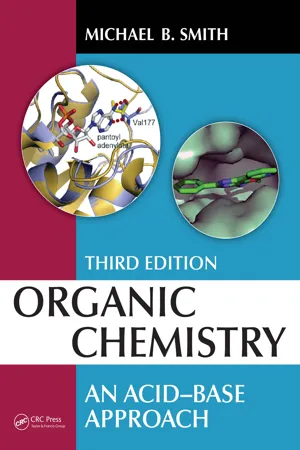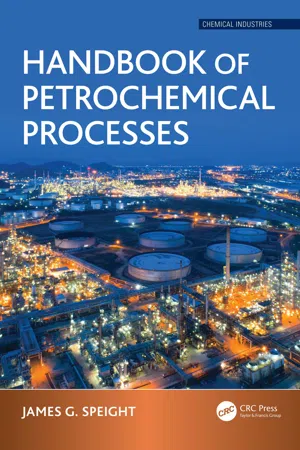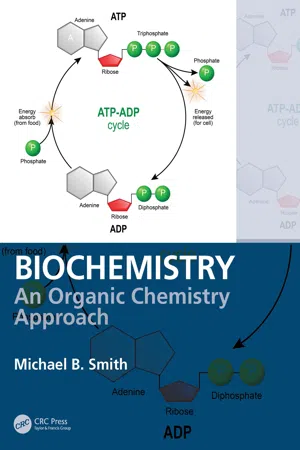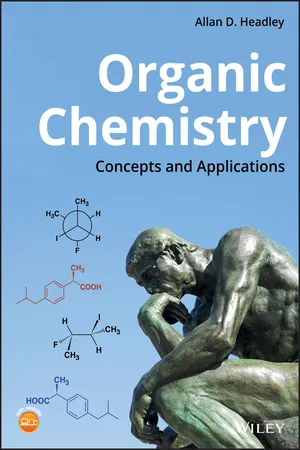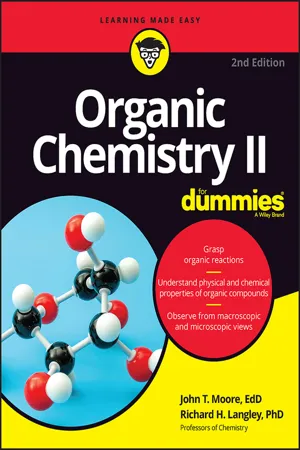Chemistry
Benzene Derivatives
Benzene derivatives are organic compounds that are derived from benzene by replacing one or more hydrogen atoms with other functional groups. These derivatives exhibit diverse chemical and physical properties, making them important in various industrial and biological processes. Common benzene derivatives include toluene, phenol, aniline, and nitrobenzene, each with distinct reactivity and applications.
Written by Perlego with AI-assistance
Related key terms
Related key terms
1 of 4
Related key terms
1 of 3
5 Key excerpts on "Benzene Derivatives"
- eBook - ePub
Organic Chemistry
An Acid-Base Approach
- Michael B. Smith(Author)
- 2022(Publication Date)
- CRC Press(Publisher)
19 Aromatic Compounds and Benzene Derivatives
DOI: 10.1201/9781003174929-19The video clips for this chapter are available at: https://routledgetextbooks.com/textbooks/9780367768706/chapter-19.phpThe scientist photographs are also available at: https://routledgetextbooks.com/textbooks/9780367768706/image-gallery.phpBenzene was identified as a special type of hydrocarbon in Section 5.9. Benzene and derivatives are aromatic hydrocarbons with one ring or several rings fused together. The aromatic character of benzene and derivatives have special stability, which imparts a unique chemical profile.To begin this chapter, you should know the following points:- Resonance and resonance-stability (Sections 2.6 and 6.3.1).
- Nomenclature and structure of alkenes, alkyl halides, alcohols, amines, aldehydes, and ketones (Sections 5.1, 5.2 5.85, and 5.6).
- Carboxylic acids and carboxylic acid derivatives (Chapter 18 ).
- The structure and nature of π-bonds (Section 5.1).
- Reactivity of alkenes (Sections 10.1–10.6).
- E2 elimination reactions of alkyl halides (Sections 12.1–12.3).
- E1 elimination reactions (Section 12.4).
- The CIP rules (Section 9.2).
- Electron-releasing and withdrawing substituents (Sections 3.8, 6.3.2).
- Brønsted-Lowry acid-base reactions of alkenes (Sections 10.5–10.7).
- Carbocation stability (Sections 7.2.1, 10.1 and 10.3).
- Leaving groups (Sections 11.1–11.3 and 18.4).
- Lewis acids and Lewis bases (Sections 2.7 and 6.8).
- Rate of reaction (Section 7.11).
- Reduction of functional groups (Sections 17.2–17.5).
19.1 Benzene and Aromaticity
Structure of BenzeneBenzene is a liquid first isolated from an oily condensate deposited from compressed illuminating gas by Michael Faraday (England; 1791–1867) in 1825. Benzene is a hydrocarbon and the parent of a large class of compounds known as aromatic hydrocarbons. In 1834, Eilhard Mitscherlich (Germany; 1794–1863) established the formula to be C6 H6 and named the material benzin. Justus Liebig (Germany; 1803–1873) changed the name to benzol. In 1837, August Laurent (France; 1807–1853) proposed the name pheno (Greek; I bear light) since it was isolated from illuminating gas. The name was not adopted, but has given rise to the term phenyl for a benzene ring used as a substituent C6 H5 - eBook - ePub
- James G. Speight(Author)
- 2019(Publication Date)
- CRC Press(Publisher)
The solvent properties of the two are similar, but toluene is less toxic and has ahigh0boiling constituents wider liquid range. Aromatic hydrocarbon derivatives, like paraffin hydrocarbon derivatives, react by substitution, but by a different mechanisms under milder reaction conditions. Aromatic compounds react by additions only under several reaction conditions. For example, electrophilic substitution of benzene using nitric acid produces nitrobenzene under normal conditions, while the addition of hydrogen to benzene occurs in presence of catalyst only under high pressure to give cyclohexane. Monosubstitution can occur at any one of the six equivalent carbon atoms of the ring. Most of the monosubstituted benzenes have common names such as toluene (methylbenzene), phenol (hydroxybenzene), and aniline (aminobenzene). When two hydrogens in the ring are substituted by the same reagent, three isomers are possible. The prefixes ortho, meta, and para are used to indicate the location of the substituents in 1,2-; 1,3-; or 1,4-positions, for example, xylene isomers. Benzene is an important chemical intermediate and is the precursor for many commercial chemicals and polymers such as phenol, styrene for polystyrene derivatives, and caprolactam for nylon 6. Chapter 10 discusses chemicals based on benzene. Benzene (C 6 H 6) is the most important aromatic hydrocarbon. It is the precursor for many chemicals that may be used as end products or intermediates. Almost all compounds derived directly from benzene are converted to other chemicals and polymers. For example, hydrogenation of benzene produces cyclohexane. Oxidation of cyclohexane produces cyclohexanone, which is used to make caprolactam for nylon manufacture. Due to the resonance stabilization of the benzene ring, it is not easily polymerized. However, products derived from benzene such as styrene, phenol, and maleic anhydride can polymerize to important commercial products due to the presence of reactive functional groups - eBook - ePub
Biochemistry
An Organic Chemistry Approach
- Michael B. Smith(Author)
- 2020(Publication Date)
- CRC Press(Publisher)
9 Aromatic Compounds and Heterocyclic CompoundsBenzene is a special type of hydrocarbon. Derivatives are known by replacing the hydrogen atoms of benzene with substituents and/or functional groups. There are hydrocarbons related to benzene that have two, three, or more rings fused together (polycyclic compounds). The unifying concept of all these molecules is that they are aromatic, which means that they are especially stable with respect to their bonding and structure.9.1 Benzene and Aromaticity
Benzene is a hydrocarbon with the formula C6 H6 . It is the parent of a large class of compounds known as aromatic hydrocarbons. The structure and chemical reactivity of aromatic hydrocarbons are so unique that Benzene Derivatives are given their own nomenclature system. This discussion will begin with the unique structure of benzene.The structure of benzene is shown in Figure 9.1 . It is known that the C—C bond length in ethane is 1.53 Å (153 pm), and the C—C bond length is 1.536 Å (153.6 pm) in cyclohexane. The bond distance for the C=C bond in ethene is 1.34 Å (134 pm). These data indicate that a C=C unit has a shorter bond distance than a C—C unit. If benzene has a structure with both single and double bonds, it should have three longer C—C single bonds and three shorter C=C units. It would then be called cyclohexatriene. It has been experimentally determined that all six carbon–carbon bonds have a measured bond distance of 1.397 Å (139.7 pm), a value that lies in between those for the C–C bond in an alkane and the C=C unit of an alkene. This observation means that the C–C bonds in benzene are not single bonds, nor are they C=C double bonds where the π-electrons are localized between two carbons in a π-bond. This molecule is not cyclohexatriene, it is benzene . Each carbon in benzene is sp2 hybridized, however, which means each has a trigonal planar geometry. The planar geometry is seen more clearly in the molecular model of benzene in Figure 9.1 - eBook - ePub
Organic Chemistry
Concepts and Applications
- Allan D. Headley(Author)
- 2019(Publication Date)
- Wiley(Publisher)
Benzene is another one of these organic compounds with a very distinctive aroma and is responsible for the odor of coal distillate. It was discovered that these organic compounds all have a special feature, which is described as aromaticity, and as result, these compounds are referred to as aromatic compounds. As you can imagine, there are numerous compounds that can be described as aromatic compounds. There are other aromatic compounds that may not have a distinct characteristic odor. Some include aspirin, morphine, norepinephrine, epinephrine, nicotine, vitamin E, and estrone. It is difficult to study all aromatic compounds individually, so we will carry out our study of aromatic compounds on the most common aromatic compound, benzene, and apply the knowledge gained to other compounds that are similar and aromatic.Benzene was isolated from compressed illuminating gas in 1825 by Michael Faraday of the Royal Institution. In 1834, Eilhardt Mitscherlich of the University of Berlin synthesized benzene by heating benzoic acid with calcium oxide and he also showed that the molecular formula of benzene is C6 H6 . Today, benzene is obtained primarily from the distillation of petroleum, and it is used in the synthesis of many useful chemicals in our society. Benzene is also a very common solvent that is used in most chemical labs, both industrial and academic. However, it was removed from teaching labs, since it was shown to cause cancer when given to laboratory animals in very large dosage. Benzene is absorbed in the blood stream from inhalation and is converted to phenols and excreted by the liver. Benzene causes skin irritation; it is thought to cause leukemia. If absorbed in the blood, it will increase the number of white blood cells and it also causes damage to bone marrow. However, it is still sometimes used, under very controlled conditions, in industrial and research labs.Since most of the chemical properties of compounds in this very large category of aromatic compounds are similar, we will study in detail the chemistry of only one of these compounds, benzene. By knowing the chemical and physical properties of benzene, we will be able to predict the properties of other aromatic compounds. In this chapter, we will first define aromaticity in a chemical sense and then apply that definition to other molecules to determine if they are aromatic or not. In the later sections of the chapter, we will examine the reactions of aromatic compounds.17.2 Structure and Properties of Benzene
It was shown that the chemical formula of benzene is C6 H6 . Based on our knowledge of the number of hydrogens that are bonded to the carbons of saturated hydrocarbons, it is obvious that benzene is not a saturated hydrocarbon. In 1866, Friedrich Kekulé proposed that benzene had a cyclic structure with three alternating double bonds, as shown in Figure 17.1 - eBook - ePub
- John T. Moore, Richard H. Langley(Authors)
- 2023(Publication Date)
- For Dummies(Publisher)
Part 2Discovering Aromatic (And Not So Aromatic) Compounds
IN THIS PART …- Examine aromatic systems, including the spectroscopy of aromatic compounds.
- Organize some aromatic substitutions by electrophiles.
- Get nucleophiles in on the aromatic substitution action.
Passage contains an image Chapter 6
Introducing Aromatics
IN THIS CHAPTERExploring benzeneCoping with the aromatic familyGetting acquainted with heterocyclic aromatic compoundsShedding light on the spectroscopy of aromatic compoundsOrganic chemistry has two main divisions. One division deals with aliphatic (fatty) compounds, the first compounds you encountered in Organic Chemistry I. Methane is a typical example of this type of compound. The second division includes the aromatic (fragrant) compounds, of which benzene is a typical example.Compounds in the two groups differ in a number of ways. The two differ chemically in that the aliphatic undergo free-radical substitution reactions and the aromatic undergo ionic substitution reactions. In this chapter, we examine the basics of both aromatic and heterocyclic aromatic compounds, concentrating on benzene and related compounds.Benzene: Where It All Starts
Benzene is the fundamental aromatic compound. An understanding of the behavior of many other aromatic compounds is much easier if you first gain an understanding of benzene. For this reason, you may find it useful to examine a few key characteristics of benzene, which we discuss in the following sections.Figuring out benzene’s structure
Benzene was first isolated in 1825 from coal tar. Later, chemists determined that it had the molecular formula C6 H6 . Further investigation of its chemical behavior showed that benzene was unlike other hydrocarbons in both structure and reactivity.Chemists proposed many structures for benzene. However, the facts didn’t support any of the possibilities until Kekulé proposed a ring structure in 1865. Some of the proposed structures, including Kekulé’s, are shown in Figure 6-1
Index pages curate the most relevant extracts from our library of academic textbooks. They’ve been created using an in-house natural language model (NLM), each adding context and meaning to key research topics.
Explore more topic indexes
Explore more topic indexes
1 of 6
Explore more topic indexes
1 of 4
